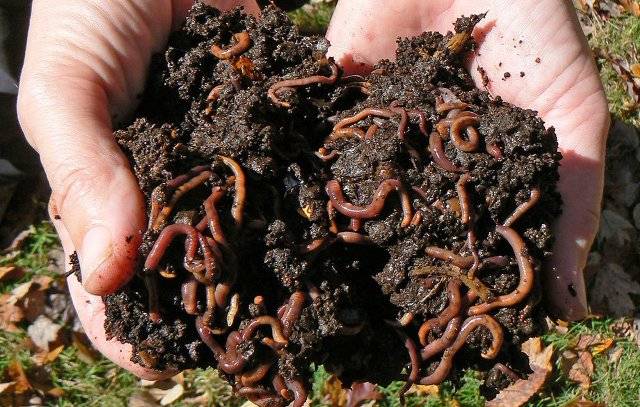
Earthworms have a special importance in soil improvement processes. They participate and involve in the soil-forming processes by influencing the pH, physical decomposition, humus formation, thus in the improvement of soil structure. Their activity is mostly in the upper layers of the soil, i.e. 15-35 cms of surface soil. The activities of earthworms which helps in soil improvement are their locomotion and digestion processes.
While in locomotion, earthworm makes burrows by pushing the soil particles. If no suitable space is available to push the head into, it swallows the soil and makes the space. The soil that is taken in by the worm passes through the digestive system and is excreted as vermi castings. These castings contains excreta, earthworm cocoons and undigested soil. As they involve in the digestion process, they come out with enriched nutrient content that improve the soil fertility and the soil productivity. Thus, the earthworms not only helps in improving the soil fertility but also mixes the soil thoroughly while in movement which adds pore space also. The vermin castings contains 2.5% N, 2.9% P and 1.4% Potash. There are several evidences of extensive earthworm activities.
When it excretes, the intestinal contents of these worms also comes out which are neutral to slightly alkaline in pH or soil reaction. At this pH, bacterial activity is enhanced. If the bacterial activity is more, the more complex organic compounds can be converted to humus. Thus, the presence of earthworms creates neutral to slightly alkaline pH in the soil and this favours the bacteria, than soil fungi which survives in an acidic pH.
The physical decomposition of soils will be resulted in the gut of earthworms result in the pulverization of soil. This pulverization of the soil particles in the gut of the digestive system creates more surface area on the soil particles. Increased surface area is beneficial to micro-organisms for further decomposition and soil forming process.
Another characteristic feature is the presence of enzyme 'cellulose' in the intestine of earthworms. The very process of humus formation involves breakdown of celluloses into simple sugars like glucose, galactose, mannose etc. and various organic acids, amino acids etc. So, the enzyme cellulose can play a very active role in humus formation and hence the earth-worms have a significant role in the humus formation.
The physical pulverization of organic particles, the amelioration of soil pH and enhancement of microbial decomposition activity are the resultant of earthworm activity in the soil. All these processes are carried out by earthworms contributing to soil fertility. The process of burrowing helps in the ingestion of organic and mineral particles and formation of organic-mineral complexes. Thus, they create electrostatic bonds between negatively charged organic particles and positively charged cations such as calcium. Organo-mineral crumbs thus formed are stable and are resistant to leaching. This improves the soil structure.
Structural improvement is further enhanced by the creation of burrow systems. While burrowing they mix the soil and the casts on the surface will be taken to the deeper parts of the profile and vice-versa. Deep burrowing species of earth-worms makes this process easy. Even the organic crumbs will be drawn into their burrows of mineral soil from the soil surface. This process also prevents the surface accumulation of acid humus. It will promote the dispersion of finely decomposed humus down the profile enriching the deeper layers of soil. Thus, thorough mixing of soil is done by these species. The amount of soil brought by an earthworm biomass of one tonne per hectare to the surface by casting is about 100 tonnes per ha per year. The soil that passes through the earthworm gut is six to ten times richer in nitrogen, phosphorus and other micro-nutrients.
A comparison of various characteristics of the soils rich in vermin castings and the normal soil are given :
Comparative characteristics of earthworm casts and normal soils
|
S.No |
Characteristics |
Earthworm cast |
Normal soil |
|
1 |
Soil & clay (%) |
38.80 |
22.20 |
|
2 |
Bulk density (Mg/m3) |
1.11 |
1.28 |
|
3 |
Structural stability (a) |
849.00 |
65.00 |
|
4 |
Cation Exchange capacity (cmols/kg) |
13.80 |
3.50 |
|
5 |
Exchangeable calcium (cmols/kg) |
8.90 |
2.00 |
|
6 |
Exchangeable Potassium (cmols/kg) |
0.60 |
0.20 |
|
7 |
Soluble phosphorus (ppm) |
17.80 |
6.10 |
|
8 |
Total nitrogen (%) |
0.33 |
0.12 |
Symbols used in the table
% -Percentage
Mg/m3 -Mega grams per meter cube
a -Number of raindrops required to destroy structural aggregates
cmoles/kg -Centimoles per kilogram
ppm -parts per million
In acid forests, an average of one to few earthworms are found per square metre while in rich grassland soils, more than 500 per square meter are recorded. In arable soils, they range from 30-300 per sq. mt. which is equal to a live-weight or biomass of 1.0-1100 kg per hectare.















